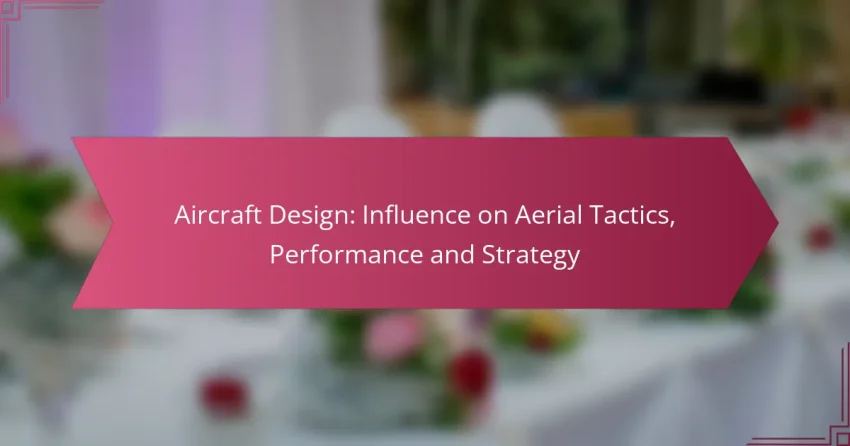Aircraft design plays a crucial role in shaping aerial tactics and military strategy by influencing maneuverability, threat response, and adaptability in combat scenarios. Key design features such as aerodynamics, avionics, and weapon systems directly affect performance metrics like speed, range, and payload capacity, ultimately determining an aircraft’s operational effectiveness. As a result, the characteristics of various aircraft designs dictate their capabilities in combat, support, and intelligence operations, which are essential for achieving strategic objectives.

How Does Aircraft Design Influence Aerial Tactics?
Aircraft design significantly impacts aerial tactics by determining how effectively a plane can maneuver, respond to threats, and adapt to various combat scenarios. Key design features such as aerodynamics, avionics, and weapon systems shape operational strategies and influence the overall performance of military engagements.
Enhanced maneuverability
Maneuverability is crucial for aircraft in combat, allowing them to evade enemy fire and position themselves advantageously. Designs that prioritize agility, such as delta wings or canards, enable tighter turns and quicker responses. For instance, modern fighter jets often feature thrust vectoring, which enhances their ability to perform complex aerial maneuvers.
However, increased maneuverability can come at the cost of speed or stability. Designers must balance these factors to ensure that the aircraft can perform effectively in various combat situations. Pilots must also be trained to exploit these capabilities to gain an edge in dogfights.
Improved situational awareness
Aircraft design plays a vital role in enhancing situational awareness through advanced avionics and sensor systems. Modern aircraft are equipped with radar, infrared, and electronic warfare systems that provide pilots with real-time data about their surroundings. This information is crucial for making informed tactical decisions during engagements.
Additionally, cockpit design influences how effectively pilots can process information. Ergonomic layouts and heads-up displays (HUDs) allow for quicker reactions and better focus on critical threats. Ensuring that pilots are trained to interpret this data is equally important for maximizing the benefits of these advanced systems.
Adaptation to combat scenarios
Aircraft must be designed to adapt to various combat scenarios, whether engaging in air superiority, ground support, or reconnaissance missions. Multi-role aircraft, such as the F-35, exemplify this adaptability by incorporating features that allow them to switch roles quickly based on mission requirements.
Designers must consider the operational environment when creating aircraft. For example, stealth technology is essential for missions requiring covert operations, while heavy payload capacity is crucial for ground attack roles. Understanding these needs helps military planners select the right aircraft for specific missions, ensuring optimal performance and effectiveness in diverse combat situations.
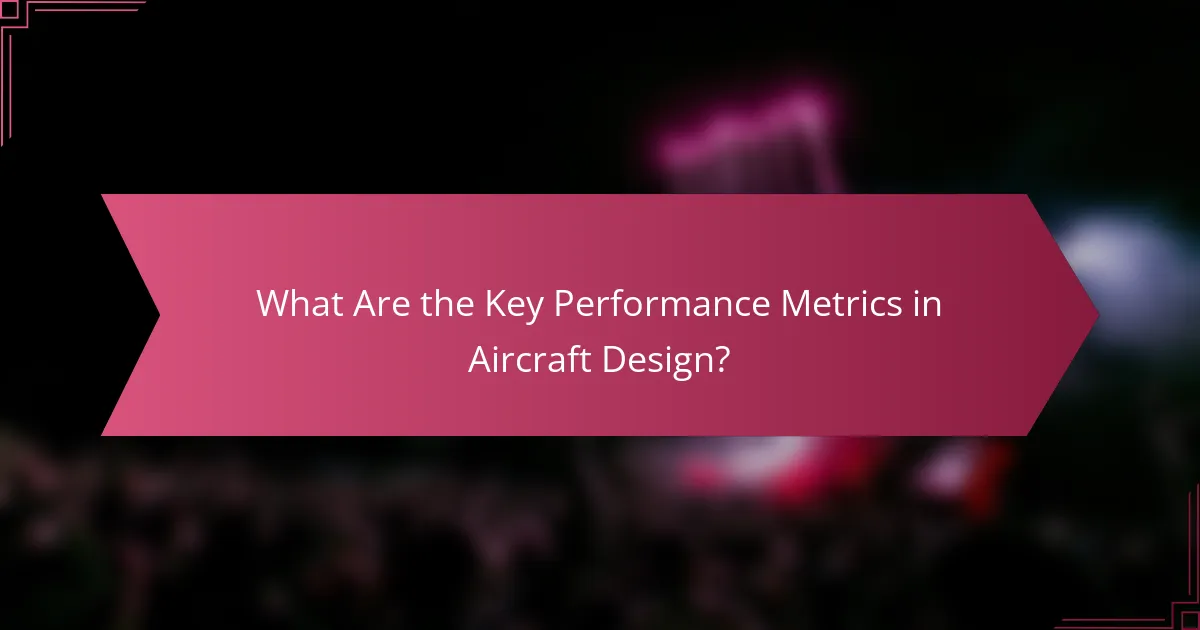
What Are the Key Performance Metrics in Aircraft Design?
The key performance metrics in aircraft design include speed and agility, range and endurance, and payload capacity. These metrics significantly influence an aircraft’s operational effectiveness and strategic capabilities in various missions.
Speed and agility
Speed and agility are crucial for aircraft performance, impacting their ability to evade threats and engage targets effectively. Faster aircraft can cover distances quickly, while agile designs allow for sharp maneuvers during combat or evasive actions.
For instance, modern fighter jets often exceed speeds of 1,000 km/h, while their agility is enhanced through advanced wing designs and thrust vectoring. When designing an aircraft, balancing speed with control is essential to ensure optimal performance in diverse scenarios.
Range and endurance
Range and endurance determine how far and how long an aircraft can operate without refueling. These metrics are vital for strategic missions, especially in military operations where extended reach can provide a tactical advantage.
Typical combat aircraft have a range of several hundred to over a thousand kilometers, depending on their fuel capacity and efficiency. Designers must consider trade-offs between fuel load and payload to maximize both range and mission effectiveness.
Payload capacity
Payload capacity refers to the total weight an aircraft can carry, including weapons, equipment, and personnel. This metric is critical for mission versatility, as it dictates the types of operations an aircraft can perform.
For example, transport aircraft may prioritize high payload capacities, often exceeding 20,000 kg, while fighter jets balance between payload and speed. Understanding the mission requirements helps in optimizing the design to meet specific operational needs without compromising performance.

How Do Different Aircraft Designs Affect Military Strategy?
Different aircraft designs significantly influence military strategy by determining capabilities in combat, support, and intelligence operations. The design characteristics dictate performance, range, and versatility, which are crucial for achieving strategic objectives.
Strategic air superiority
Strategic air superiority is achieved when a military can dominate the airspace, preventing enemy aircraft from operating effectively. Aircraft designed for speed, agility, and advanced avionics, such as fighter jets, play a vital role in establishing this dominance.
Key considerations include the aircraft’s maneuverability, weapon systems, and radar capabilities. For instance, stealth technology in modern fighters allows them to evade detection, enhancing their effectiveness in gaining air superiority.
Ground support capabilities
Ground support capabilities are essential for providing close air support to ground troops. Aircraft designed for this purpose, such as attack helicopters and ground-attack planes, are equipped with precision weapons and can operate at lower altitudes to engage targets effectively.
When selecting aircraft for ground support, factors like payload capacity, range, and response time are critical. For example, an aircraft with a rapid deployment capability can significantly enhance ground forces’ operational effectiveness during critical moments.
Intelligence, surveillance, and reconnaissance
Intelligence, surveillance, and reconnaissance (ISR) are crucial for informed military decision-making. Aircraft designed for ISR missions, such as drones and reconnaissance planes, are equipped with advanced sensors and imaging technology to gather real-time data.
Effective ISR aircraft must have long endurance and the ability to operate at various altitudes. For example, unmanned aerial vehicles (UAVs) can remain airborne for extended periods, providing continuous surveillance over a designated area, which is invaluable for strategic planning and execution.
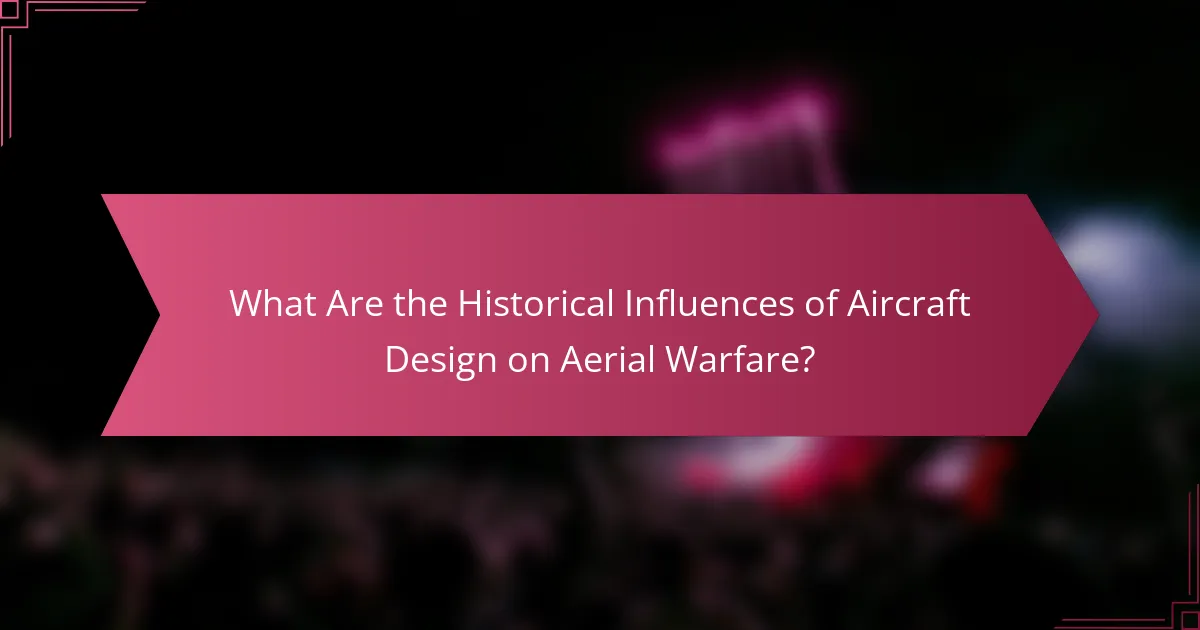
What Are the Historical Influences of Aircraft Design on Aerial Warfare?
Aircraft design has profoundly shaped aerial warfare by influencing tactics, performance, and strategic outcomes. Historical developments in aircraft technology have led to significant shifts in how air power is utilized in military operations.
World War I innovations
World War I marked the beginning of serious aerial combat, with innovations such as the introduction of the fighter plane and the use of reconnaissance aircraft. The design of biplanes allowed for greater maneuverability and the ability to engage in dogfights, fundamentally changing aerial tactics.
Key aircraft like the Sopwith Camel and the Fokker Dr.I showcased advancements in speed and agility, enabling pilots to execute complex maneuvers. The emphasis on lightweight structures and powerful engines set the stage for future developments in military aviation.
World War II advancements
World War II saw dramatic advancements in aircraft design, including the introduction of long-range bombers and jet propulsion. The B-29 Superfortress, for example, featured pressurized cabins and advanced navigation systems, allowing for strategic bombing campaigns over vast distances.
Fighter aircraft like the P-51 Mustang combined speed, range, and firepower, which significantly improved air superiority tactics. The shift towards all-metal construction and more powerful engines increased performance and operational effectiveness in various combat scenarios.
Cold War developments
During the Cold War, aircraft design focused on stealth technology, supersonic speeds, and advanced avionics. The introduction of aircraft like the F-117 Nighthawk demonstrated how design could minimize radar visibility, changing the dynamics of aerial warfare.
Additionally, the development of multi-role fighters, such as the F-15 and F-16, allowed for versatility in missions ranging from air-to-air combat to ground support. These advancements reflected the strategic need for adaptability in a rapidly evolving geopolitical landscape.
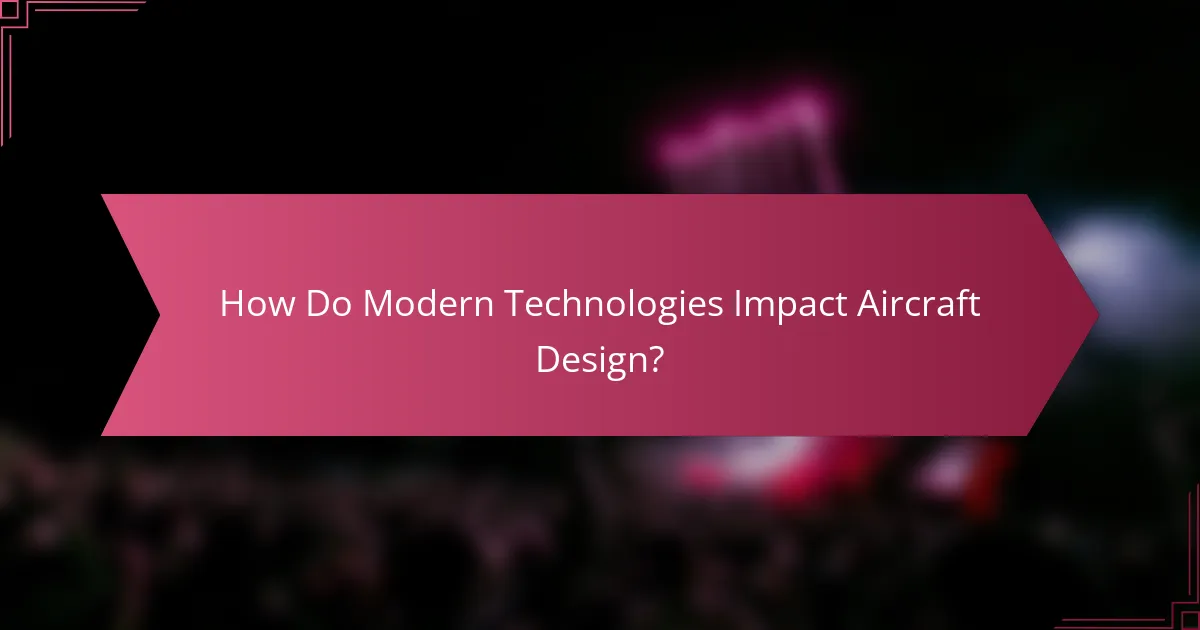
How Do Modern Technologies Impact Aircraft Design?
Modern technologies significantly influence aircraft design by enhancing performance, efficiency, and operational capabilities. Innovations such as stealth technology, advanced avionics, and materials science are reshaping how aircraft are built and utilized in various aerial tactics and strategies.
Stealth technology
Stealth technology is designed to minimize an aircraft’s radar cross-section, making it harder to detect. This is achieved through specific shapes, special coatings, and the use of absorbent materials that reduce radar reflections. For example, the B-2 Spirit bomber employs these principles to operate undetected in hostile airspace.
Incorporating stealth features often involves trade-offs, such as increased weight or reduced payload capacity. Designers must balance these factors to maintain the aircraft’s overall mission effectiveness while achieving low observability.
Advanced avionics
Advanced avionics enhance aircraft performance by integrating sophisticated navigation, communication, and control systems. These systems improve situational awareness, allowing pilots to make informed decisions quickly. For instance, modern fighter jets utilize heads-up displays (HUDs) that project critical flight data directly into the pilot’s line of sight.
Investing in advanced avionics can lead to increased operational costs, but the benefits often outweigh these expenses. Aircraft equipped with cutting-edge avionics can execute complex missions more efficiently and with greater precision, resulting in improved tactical outcomes.
Materials science innovations
Innovations in materials science have led to the development of lighter, stronger, and more durable materials for aircraft construction. Composite materials, such as carbon fiber reinforced polymers, are increasingly used to reduce weight while maintaining structural integrity. This shift allows for better fuel efficiency and enhanced performance.
However, the use of advanced materials can increase production costs and complicate maintenance. Designers must consider these factors when selecting materials to ensure that the benefits align with the aircraft’s intended use and operational budget.
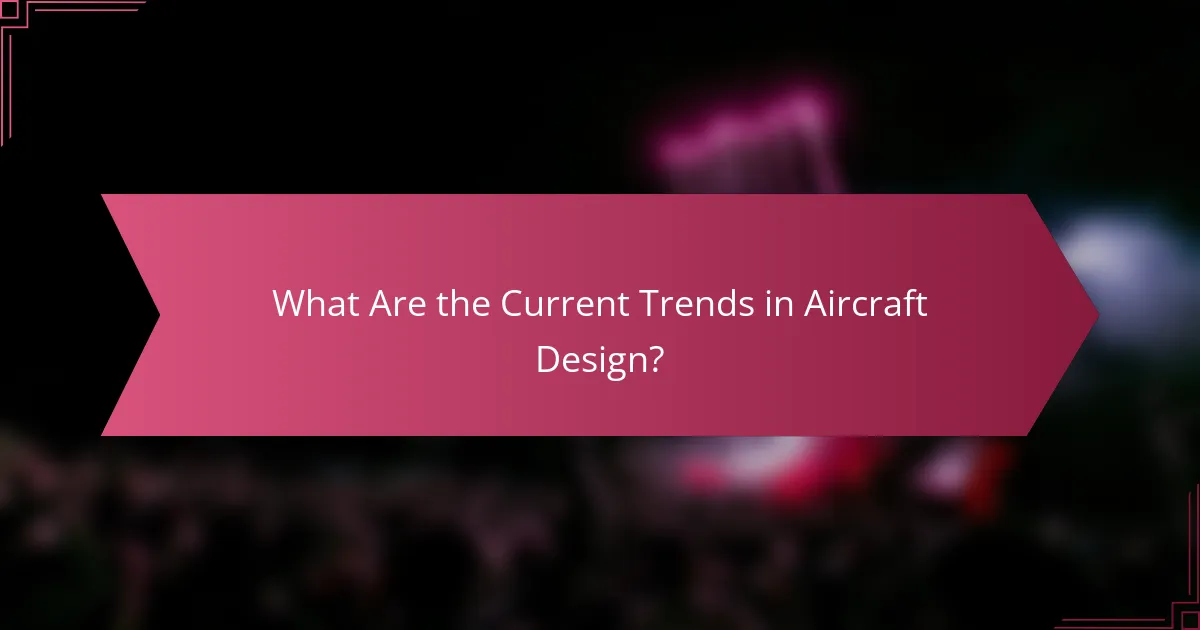
What Are the Current Trends in Aircraft Design?
Current trends in aircraft design focus on enhancing efficiency, reducing environmental impact, and integrating advanced technologies. Key developments include the rise of unmanned aerial vehicles and hybrid-electric propulsion systems, which are reshaping how aircraft operate and perform in various environments.
Unmanned aerial vehicles
Unmanned aerial vehicles (UAVs), commonly known as drones, are increasingly utilized in both military and civilian applications. These aircraft can operate without a human pilot on board, allowing for missions in hazardous environments and reducing operational risks.
UAVs vary widely in size and capability, from small quadcopters used for aerial photography to larger systems designed for reconnaissance and surveillance. Their design often emphasizes lightweight materials and advanced sensors, enabling longer flight times and greater maneuverability.
When considering UAV deployment, it’s crucial to understand local regulations regarding airspace use and privacy. In many areas, operators must obtain specific licenses and adhere to operational guidelines to ensure safety and compliance.
Hybrid-electric propulsion
Hybrid-electric propulsion systems combine traditional jet engines with electric motors, aiming to improve fuel efficiency and reduce emissions. This approach allows aircraft to utilize electric power during certain phases of flight, such as takeoff and landing, which can significantly decrease fuel consumption.
Designing hybrid-electric aircraft involves balancing weight, power output, and battery technology. While current battery capacities may limit the range of fully electric flights, hybrid systems can extend operational capabilities while still benefiting from reduced environmental impact.
As this technology evolves, manufacturers must consider the trade-offs between performance and sustainability. Investing in hybrid-electric designs can lead to long-term savings and compliance with increasingly stringent environmental regulations in many regions.
